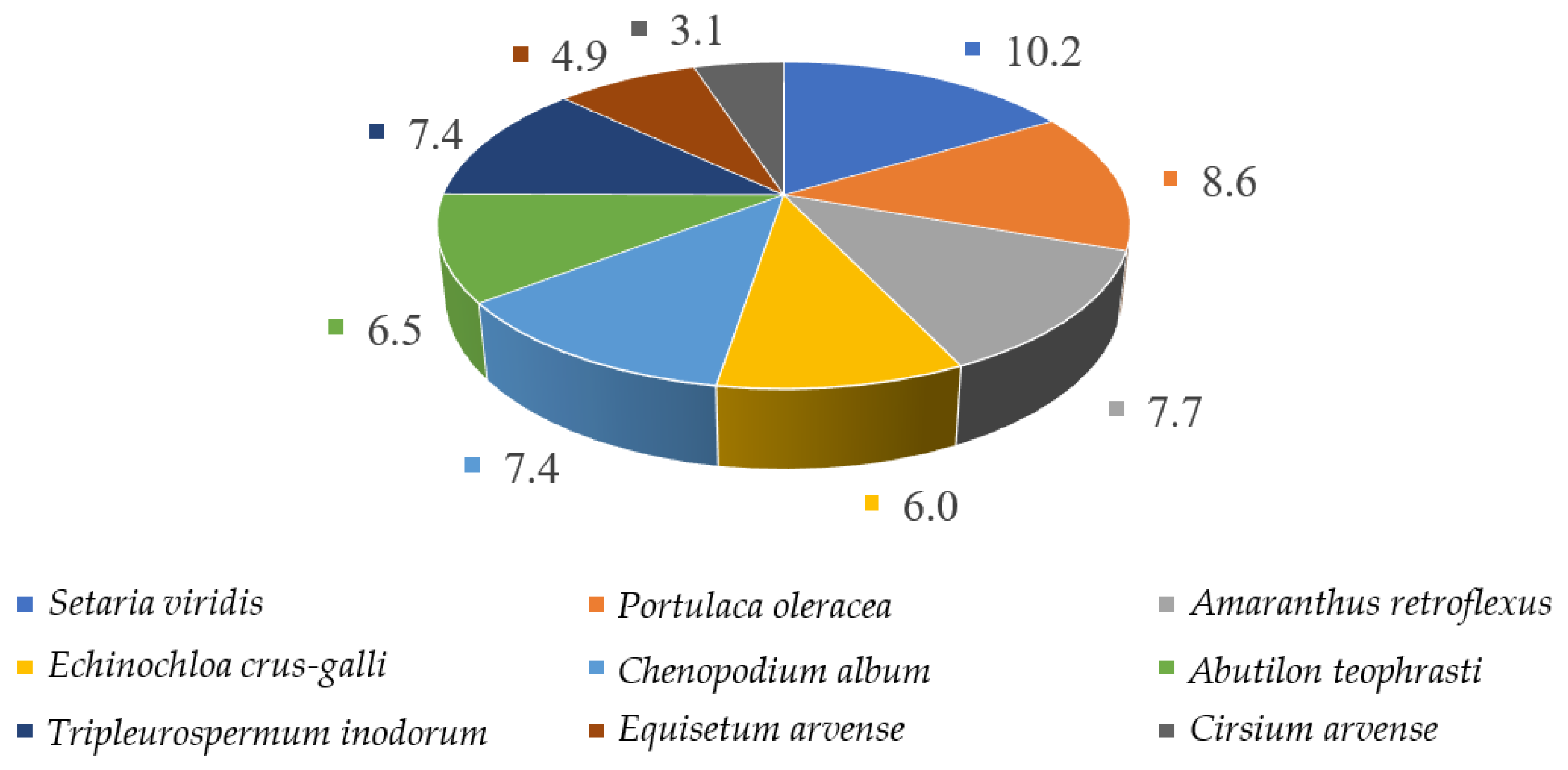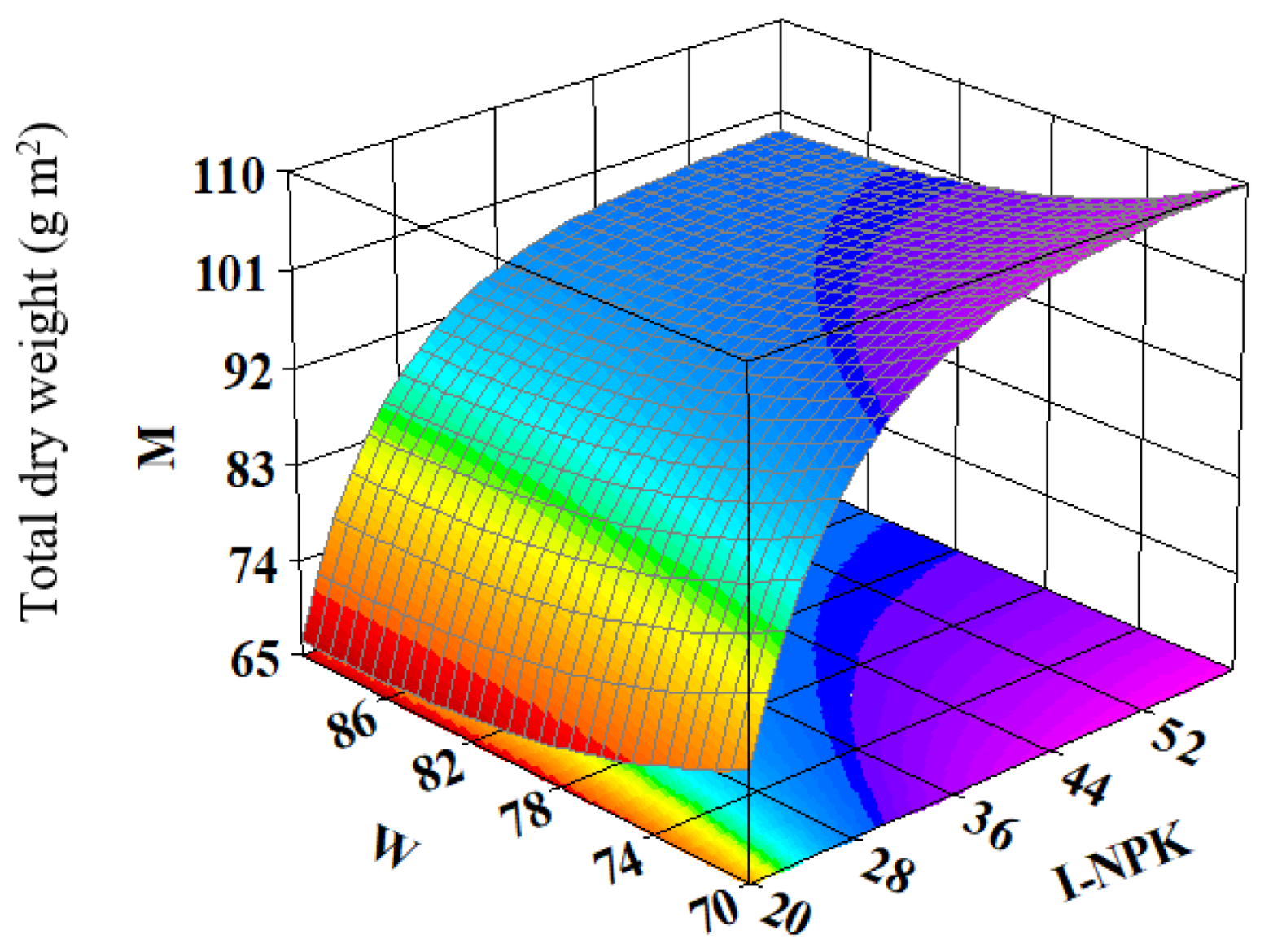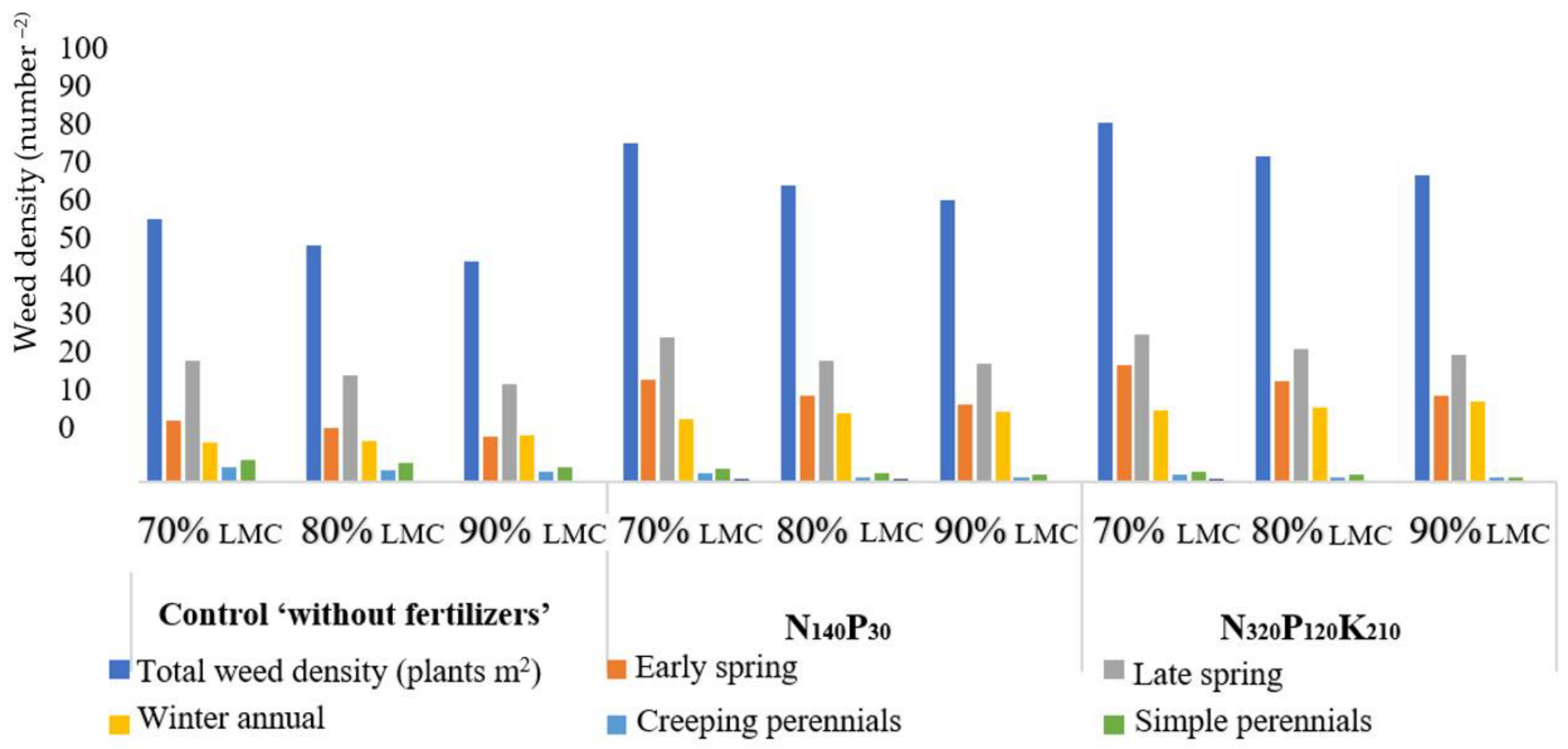Macronutrient Applications and Irrigation Regimes Impact Weed Dynamics and Weed Seedbank Augmentation in Solanum melongena L. Fields
Abstract
:1. Introduction
2. Materials and Methods
2.1. Experimental Site Description
2.2. Design of Experiments
2.3. Least Moisture Capacity % (LMC)
2.4. Soil Seed Bank Sampling
2.5. Weed Sampling
2.6. Data Analysis
3. Results and Discussion
4. Conclusions
Author Contributions
Funding
Institutional Review Board Statement
Data Availability Statement
Acknowledgments
Conflicts of Interest
References
- Kuriata, V.; Rohach, V.; Rohach, T.; Khranovska, T. The use of different minerals with vari-ous on morphogenesis and production process regulation in eggplant Solanum melongena (Solanaceae). Vestn. Biol. Ecol. 2016, 24, 230–233. [Google Scholar] [CrossRef] [Green Version]
- Khadka, R.B.; Marasini, M.; Rawal, R.; Testen, A.L.; Miller, S.A. Effects of anaerobic soil disinfestation carbon sources on soilborne diseases and weeds of okra and eggplant. Crop Prot. 2020, 35, 104846. [Google Scholar] [CrossRef]
- Zargar, M.; Bayat, M.; Astarkhanova, T. Study of postemergence-directed herbicides for red-root pigweed (Amaranthus retroflexus L.) control in winter wheat in southern Russia. J. Plant Prot. Res. 2020, 60, 7–13. [Google Scholar] [CrossRef]
- Jiang, M.; Liu, T.; Huang, N.; Shen, X.; Shen, M.; Dai, Q. Effect of long-term fertilization on the weed community of a winter wheat field. Sci. Rep. 2018, 8, 4017. [Google Scholar] [CrossRef] [PubMed] [Green Version]
- Artemyev, A.A.; Guryanov, A.M. The influence of technologies for the use of mineral fertilizers on the contamination of field crop rotation. Agrar. Sci. Euro-North-East 2018, 67, 109–114. [Google Scholar]
- Tarek, A.E. Chemical Fertilizer Could Offer a Real Solution for Minimizing Over Consumption of Herbicides for Controlling Weeds in Faba Bean. Trends Appl. Sci. Res. 2008, 3, 142–153. [Google Scholar]
- Nichols, V.; Verhulst, N.; Cox, R.; Govaerts, B. Weed Dynamics and Conservation Agriculture Principles: A Review. Field Crops Res. 2015, 183, 56–68. [Google Scholar] [CrossRef] [Green Version]
- Parvin, S.; Uddin, S.; Fitzgerald, G.; Tausz-Posch, S.; Armstrong, R.; Tausz, M. Free air CO2 enrichment (FACE) improves water use efficiency and moderate drought effect on N2 fixation of Pisum sativum L. Plant Soil 2019, 436, 587–606. [Google Scholar] [CrossRef]
- Wei, Y.; Jin, J.; Jiang, S.; Ning, S.; Liu, L. Quantitative Response of Soybean Development and Yield to Drought Stress during Different Growth Stages in the Huaibei Plain, China. Agronomy 2018, 8, 97. [Google Scholar] [CrossRef] [Green Version]
- Conley, D.J.; Paerl, H.W.; Howarth, R.W.; Boesch, D.F.; Seitzinger, S.P.; Havens, K.E.; Lancelot, C.; Likens, G.E. Controlling eutrophication: Nitrogen and phosphorus. Science 2009, 323, 1014–1015. [Google Scholar] [CrossRef]
- Li, R.H.; Qiang, S. Composition of floating weed seeds in lowland rice fields in China and the effects of irrigation frequency and previous crops. Weed Res. 2009, 49, 417–427. [Google Scholar] [CrossRef]
- Little, N.G.; DiTommaso, A.; Westbrook, A.S.; Ketterings, Q.M.; Mohler, C.L. Effects of fertility amendments on weed growth and weed–crop competition: A review. Weed Sci. 2021, 69, 132–146. [Google Scholar] [CrossRef]
- Dudkin, I.V.; Dudkina, T.A. Littering of crops in the application of mineral fertilizers. Vestn. Kurgan. GSA 2018, 3, 14–20. [Google Scholar]
- Blackshaw, R.E.; Molnar, L.J. Phosphorus fertilizer application method affects weed growth and competition with wheat. Weed Sci. 2009, 57, 311–318. [Google Scholar] [CrossRef]
- Sengxua, P.; Jackson, T.; Simali, P.; Vial, L.K.; Douangboupha, K.; Clarke, E.; Harnpichitvitaya, D.; Wade, L.J. Integrated nutrient-weed management under mechanised dry direct seeding (DDS) is essential for sustained smallholder adoption in rainfed lowland rice (Oryza sativa L.). Exp Agric. 2019, 55, 509–525. [Google Scholar] [CrossRef]
- Blackshaw, R.E.; Brandt, R.N.; Janzen, H.H.; Entz, T.; Grant, C.A.; Derksen, D.A. Differential response of weed species to added nitrogen. Weed Sci. 2003, 51, 532–539. [Google Scholar] [CrossRef]
- Blackshaw, R.E.; Brandt, R.N. Nitrogen fertilizer rate effects on weed competitiveness is species dependent. Weed Sci. 2008, 56, 743–747. [Google Scholar] [CrossRef]
- DiTomaso, J.M. Approaches for improving crop competitiveness through the manipulation of fertilization strategies. Weed Sci. 1995, 43, 491–497. [Google Scholar] [CrossRef]
- DiTommaso, A.; Mohler, C.L.; Westbrook, A.S. Response of hairy galinsoga (Galinsoga quadriradiata) to nitrogen, phosphorus, and competition from lettuce. Weed Sci. 2022, 70, 579–586. [Google Scholar] [CrossRef]
- Lindquist, J.L.; Evans, S.; Shapiro, C.; Knezevic, Z. Effect of Nitrogen Addition and Weed Interference on Soil Nitrogen and Corn Nitrogen Nutrition. Weed Technol. 2010, 24, 50–58. [Google Scholar] [CrossRef] [Green Version]
- Davis, A.S.; Liebman, M. Nitrogen source influences wild mustard growth and competitive effect on sweet corn. Weed Sci. 2001, 49, 558–566. [Google Scholar] [CrossRef]
- Evans, S.P.; Knezevic, S.; Shapiro, C.; Lindquist, J. Nitrogen application influences the critical period for weed control in corn. Weed Sci. 2003, 51, 408–417. [Google Scholar] [CrossRef] [Green Version]
- Evans, S.P.; Knezevic, S.; Shapiro, C.; Lindquist, J. Influence of nitrogen and duration of weed interference on corn growth and development. Weed Sci. 2003, 51, 546–556. [Google Scholar] [CrossRef]
- Sweeney, A.E.; Renner, K.A.; Laboski, C.; Davis, A. Effect of fertilizer nitrogen on weed emergence and growth. Weed Sci. 2008, 56, 714–721. [Google Scholar] [CrossRef]
- Baskin, C.C.; Baskin, J.M. Seeds: Ecology, Biogeography, and Evolution of Dormancy and Germination, 2nd ed; Elsevier: San Diego, CA, USA, 2014; 666p. [Google Scholar]
- Vasileiadis, V.P.; Froud-Williams, R.J.; Eleftherohorinos, I.G. Vertical distribution, size and composition of the weed seedbank under various tillage and herbicide treatments in a sequence of industrial crops. Weed Res. 2007, 47, 222–230. [Google Scholar] [CrossRef]
- John, K.N.; Valentin, V.; Abdullah, B.; Bayat, M.; Kargar, M.H.; Zargar, M. Weed mapping technologies in discerning and managing weed infestation levels of farming systems. Res. Crops 2020, 21, 93–98. [Google Scholar]
- Lindquist, J.L.; Barker, D.; Knezevic, S.; Martin, A.; Walters, D. Comparative nitrogen uptake and distribution in corn and velvetleaf (Abutilon theophrasti). Weed Sci. 2007, 55, 102–110. [Google Scholar] [CrossRef]
- Pohl, A.; Grabowska, A.; Kalisz, A.S. Biostimulant application enhances fruit setting in egg-plant-an insight into the biology of flowering. Agronomy 2019, 9, 482. [Google Scholar] [CrossRef] [Green Version]
- Johnson, W.G.; Ott, E.J.; Gibson, K.D.; Nielsen, R.L.; Bauman, T.T. Influence of nitrogen application timing on low density giant ragweed (Ambrosia trifida) interference in corn. Weed Technol. 2007, 21, 763–767. [Google Scholar] [CrossRef]
- Hrdličková, J.; Hejcman, M.; Křišťálová, V.; Pavlů, V. Production, size, and germination of broad-leaved dock seeds collected from mother plants grown under different nitrogen, phosphorus, and potassium supplies. Weed Biol. Manag. 2011, 11, 190–201. [Google Scholar] [CrossRef]
- Sallume, M.; Sarheed, B.; Abood, M.; Hamdi, G. Influence of foliar fertilization of amino decimate on growth and yield of eggplant (Solanum melongena) under water stress condition. Res. Crops 2020, 21, 557–562. [Google Scholar] [CrossRef]
- Ghadamkheir, M.; Vladimirovich, K.P.; Orujov, E.; Bayat, M.; Madumarov, M.M.; Avdotyin, V.; Zargar, M. Influence of sulfur fertilization on infection of wheat Take-all disease caused by the fungus Gaeumannomyces graminis var. tritici. Res. Crops 2020, 21, 627–633. [Google Scholar]
- Qurbanov, S.A.; Magomedova, D.S.; Karaeva, L.Y. Influence of the density of standing on the weed control of sunflower crops and its yield components. Agrar. Russ. 2018, 10, 28–31. [Google Scholar]
- Nazir, A.; Bhat, M.A.; Bhat, T.A.; Fayaz, S.; Mir, M.S.; Basu, U.; Ahanger, S.A.; Altaf, S.; Jan, B.; Lone, B.A.; et al. Comparative Analysis of Rice and Weeds and Their Nutrient Partitioning under Various Establishment Methods and Weed Management Practices in Temperate Environment. Agronomy 2022, 12, 816. [Google Scholar] [CrossRef]
- Sokolov, A.S.; Bayrambekov, S.; Sokolova, G.F. Influence of soil cultivation, fertilizers, herbicides on weediness and yield of vegetable crops in crop rotation. Successes Mod. Nat. Sci. 2018, 8, 78–84. [Google Scholar]
- Voronov, S.I.; Borodychev, V.; Pleskachev, Y.; Basakin, M.; Shiyanov, K. The influence of soil cultivation methods on weed control and productivity of winter wheat. Agrar. Russ. 2020, 2, 3–7. [Google Scholar]
- Borodycheva, V.V.; Gurenko, M.V.; Shishlyannikova, M.V.; Vybornova, V.V.; Zaitsev, V.A. Drip irrigation of onions. IOP Conf. Ser. Earth Environ. Sci 2021, 843, 012064. [Google Scholar] [CrossRef]
- Iannone, B.V.; Galatowitsch, S.M. Altering Light and Soil N to Limit Phalaris Arundinacea Reinvasion in Sedge Meadow Restorations. Restor Ecol. 2003, 16, 689–701. [Google Scholar] [CrossRef]
- Zargar, M.; John, K.N.; Bayat, M.; Pakina, E. Wild Mustard (Sinapis arvensis) Competition and Control in Rain-Fed Spring Wheat (Triticum aestivum L.). Agronomy 2021, 11, 2306. [Google Scholar] [CrossRef]
- Cathcart, R.J.; Swanton, C.J. Nitrogen Management Will Infuence Treshold Values of Green Foxtail (Setaria Viridis) in Corn. Weed Sci. 2003, 51, 975–986. [Google Scholar] [CrossRef]
- Savoy, H.J. Procedures Used by State Soil Testing Laboratories in the Southern Region of the United States. Southern Cooperative Series Bulletin No. 409. June, 2013 Revision. Available online: http://www.clemson.edu/sera6/ (accessed on 20 August 2013).
- Santos, B.M.; Dusky, J.A.; Stall, W.M.; Bewick, T.A.; Shilling, D. Mechanisms of interference of smooth pigweed (Amaranthus hybridus) and common purslane (Portulaca oleracea) on lettuce as influenced by phosphorus fertility. Weed Sci. 2004, 52, 78–82. [Google Scholar] [CrossRef]
- De Cauwer, B.; De Cuypere, T.; De Ryck, S.; Delanote, L.; DeWaele, K.; Willekens, K.; Reheul, D. Reduction in field emergence and seedbank density of Galinsoga quadriradiata and other weeds after contrasting false seedbed strategies in organic vegetable fields. Weed Res. 2019, 59, 265–278. [Google Scholar] [CrossRef]





| Fertilizer Rates (Kg ha−1) NPK | Pre-Irrigation Threshold of Soil Moisture (% Least Moisture Capacity) (LMC) | Weed Density (Number m−2) | Total Weed Dry Weight (g m−2) | ||
|---|---|---|---|---|---|
| Total | Annuals | Perennials | |||
| 20 days after planting | |||||
| Control ‘Nontreated’ | 70 | 73.2 e | 62.4 d | 10.8 a | 74.5 d |
| 80 | 66.4 f | 56.8 e | 9.6 ab | 68.3 de | |
| 90 | 63.7 fg | 55.6 e | 8.1 bc | 66.7 e | |
| 40 tons manure and N140P30 | 70 | 90.8 b | 84.3 b | 6.5 d | 101.1 a |
| 80 | 82.3 c | 77.2 c | 5.1 e | 91.8 b | |
| 90 | 79.0 d | 74.8 c | 4.2 f | 89.3 bc | |
| 40 tons manure and N320P120K210 | 70 | 96.5 a | 91.1 a | 5.4 e | 109.4 a |
| 80 | 87.7 bc | 83.9 b | 3.8 f | 101.2 a | |
| 90 | 85.9 bc | 83.2 b | 2.7 g | 99.7 ab | |
| LSD05 | 3.8 | 3.1 | 2.6 g | 4.4 | |
| 40 days after planting | |||||
| Control ‘Nontreated’ | 70 | 59.3 d | 50.1 d | 9.2 a | 42.1 cd |
| 80 | 53.4 e | 45.8 e | 7.6 b | 38.4 d | |
| 90 | 49.8 f | 43.3 e | 6.5 c | 36.3 e | |
| 40 tons manure and N140P30 | 70 | 76.3 b | 70.2 ab | 6.1 c | 58.7 b |
| 80 | 66.8 cd | 62.4 c | 4.4 d | 52.1 bc | |
| 90 | 63.6 cd | 60.1 c | 3.5 e | 49.6 c | |
| 40 tons manure and N320P120K210 | 70 | 81.2 a | 76.3 a | 4.9 d | 65.0 a |
| 80 | 73.5 bc | 69.8 b | 3.7 e | 59.5 b | |
| 90 | 69.1 c | 66.4 bc | 2.7 f | 56.7 b | |
| LSD 05 | 3.3 | 1.9 | 5.3 | 2.4 | |
| Measured Traits | Variables | R2 | |||||
|---|---|---|---|---|---|---|---|
| Annual weeds N1 (plant m−2) | 178 | 891 | −18,548 | −23,760 | 845,040 | −11,163 | 0.97 |
| perennial weeds N2 (plant m−2) | −7.56 | −182 | 1266 | 5280 | −17,640 | −313 | 0.93 |
| Total dry weed mass M (g m−2) | 206 | 1012 | −20,940 | −26,760 | 970,200 | −18,684 | 0.95 |
| Fertilizer Rates (Kg ha−1) NPK | Pre-Irrigation Soil Moisture Threshold (% Least Moisture Capacity) (LMC) | Million Seeds ha−1 | Compared to Control | ||
|---|---|---|---|---|---|
| Beginning of Growing Season | End of the Growing Season | Million Seeds ha−1 | % | ||
| Control ‘Nontreated’ | 70 | 264 | 212 | - | - |
| 80 | 261 | 231 | −33 | −12.5 | |
| 90 | 265 | 240 | −24 | −9.1 | |
| 40 tons manure N140P30 | 70 | 259 | 197 | −67 | −25.4 |
| 80 | 266 | 215 | −49 | −18.6 | |
| 90 | 263 | 222 | −42 | −15.9 | |
| 40 tons manure N320P120K210 | 70 | 262 | 193 | −71 | −26.9 |
| 80 | 258 | 211 | −53 | −20.1 | |
| 90 | 260 | 215 | −49 | −18.6 | |
| LSD 05 | 16 | 13 | |||
| Coefficient of variation (%) | 11.34 | 4.49 | |||
| Fertilizer Rates (Kg ha−1) NPK | Pre-Irrigation Threshold of Soil Moisture (% Least Moisture Capacity) (LMC) | Eggplant Yield | Yield Increase | |
|---|---|---|---|---|
| (t h−1) | (t h−1) | % | ||
| Control ‘Nontreated’ | 70 | 22.1 ef | - | - |
| 80 | 24.9 e | 2.8 | 12.7 | |
| 90 | 25.3 e | 3.2 | 14.5 | |
| 40 tons manure N140P30 | 70 | 32.5 cd | 10.4 | 47.0 |
| 80 | 36.7 c | 14.6 | 66.0 | |
| 90 | 37.9 c | 15.8 | 71.4 | |
| 40 tons manure N320P120K210 | 70 | 40.8 b | 18.7 | 84.6 |
| 80 | 42.3 a | 20.2 | 91.4 | |
| 90 | 44.1 a | 22.0 | 99.5 | |
| LSD 05 | - | 0.0102 | 0.029 | 0.0050 |
| Coefficient of variation (%) | - | 6.60 | 9.11 | 3.99 |
Disclaimer/Publisher’s Note: The statements, opinions and data contained in all publications are solely those of the individual author(s) and contributor(s) and not of MDPI and/or the editor(s). MDPI and/or the editor(s) disclaim responsibility for any injury to people or property resulting from any ideas, methods, instructions or products referred to in the content. |
© 2022 by the authors. Licensee MDPI, Basel, Switzerland. This article is an open access article distributed under the terms and conditions of the Creative Commons Attribution (CC BY) license (https://creativecommons.org/licenses/by/4.0/).
Share and Cite
Zargar, M.; Magomedova, D.; Kurbanov, S.; Pleskachiov, Y.; Pakina, E. Macronutrient Applications and Irrigation Regimes Impact Weed Dynamics and Weed Seedbank Augmentation in Solanum melongena L. Fields. Agriculture 2023, 13, 22. https://doi.org/10.3390/agriculture13010022
Zargar M, Magomedova D, Kurbanov S, Pleskachiov Y, Pakina E. Macronutrient Applications and Irrigation Regimes Impact Weed Dynamics and Weed Seedbank Augmentation in Solanum melongena L. Fields. Agriculture. 2023; 13(1):22. https://doi.org/10.3390/agriculture13010022
Chicago/Turabian StyleZargar, Meisam, Diana Magomedova, Serazhutdin Kurbanov, Yurii Pleskachiov, and Elena Pakina. 2023. "Macronutrient Applications and Irrigation Regimes Impact Weed Dynamics and Weed Seedbank Augmentation in Solanum melongena L. Fields" Agriculture 13, no. 1: 22. https://doi.org/10.3390/agriculture13010022







